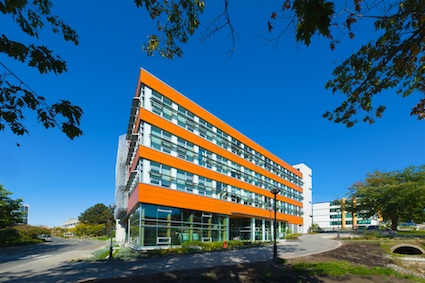North America’s Greenest Building Hopes to Pave Path for Sustainable Design
 VANCOUVER — The University of British Columbia claims they have the “greenest building” in North America and will provide net positive energy benefits to the environment. The $37 million construction of the school’s Centre for Interactive Research on Sustainability (CIRS) has met LEED Platinum standards and has also met the Living Building Challenge (LBC) — known to be the most stringest sustainability certification system.
VANCOUVER — The University of British Columbia claims they have the “greenest building” in North America and will provide net positive energy benefits to the environment. The $37 million construction of the school’s Centre for Interactive Research on Sustainability (CIRS) has met LEED Platinum standards and has also met the Living Building Challenge (LBC) — known to be the most stringest sustainability certification system.
“Unsustainable buildings are 100-year mistakes that affect us all, so accelerating the adoption of green practices is crucial,” says John Robinson, a professor in UBC’s Dept. of Geography and Institute of Resources. “CIRS will serve as an agent of change, providing cities and builders a model to learn from, improve on and ultimately surpass.”
The 60,000-square-foot building, designed by architecture firm Perkin+Will’s Vancouver office, reduces UBC’s carbon emissions, powers itself and a neighboring building with renewable and waste energy, creates drinking water from rain, and treats wastewater on-site, according to a university statement.
CIRS is one of four flagship projects totaling more than $150 million when complete. Innovations that result from the center and other campus sustainability projects will help UBC to achieve the most aggressive carbon-reduction targets at any major research university, according to university officials. The university aims to achieve a 33 percent reduction of greenhouse gas emissions at the Vancouver campus by 2015, 67 percent reduction by 2020 and 100 percent reduction by 2050.
The building’s design and orientation makes maximum use of daylight and shading for its lighting scheme to eliminate the need for constant artificial lighting and is equipped with a “living wall” that provides shade on the western side of the building during the summer months.
The living wall is constructed of a metal framework and mesh and then planted with chocolate vines that live well in containers and climb vigorously up the wall, covering it in greenery. During the winter the wall drops its leaves and allows sunlight through the building, warming the interior space.
Perkins+Will designed the facility as a U-shaped building with narrow wings to create extensive wall exposure — making it possible for window surfaces to provide natural light and fresh air.
Along with the sustainable design is a heat-recovery system that captures waste heat from the nearby Earth and Ocean Sciences (EOS) building’s laboratory exhaust system. It then transfers that heat to smaller heat pumps that provide the main heating and cooling for CIRS. Excess heat from the exchange gets channeled back to the EOS building in a usable form. A “net positive” result comes from the fact that more energy is created than consumed by the building.
The university says the new building will return 600-megawatt hours of surplus energy back to campus. The building requires no fossil fuels and will remove an additional 150 tonnes of greenhouse gas emissions annually through reduced natural gas use.
The sustainable super-building also taps into geothermal energy, and includes solar power systems installed on the roof and into sunshades on the windows.
In addition to its net zero energy design, the building is also designed for self-sufficiency in water, with all potable water entering through an installed rainwater collection on the building’s roof that is channeled to an underground cistern for filtering and treatment. The cistern is designed to hold a three-month supply of water for the building.
CIRS will house more than 200 students from several academic disciplines, including applied science, psychology, geography, forestry and business, and operational units like the UBC Sustainability Initiative (USI), which works collaboratively to integrate the university’s academic and operational efforts on sustainability.
“CIRS is a place for big ideas that make big impacts,” said Robinson. “It will serve as a living laboratory to test, learn, teach, apply and share the outcomes of sustainability focused inquires.”
